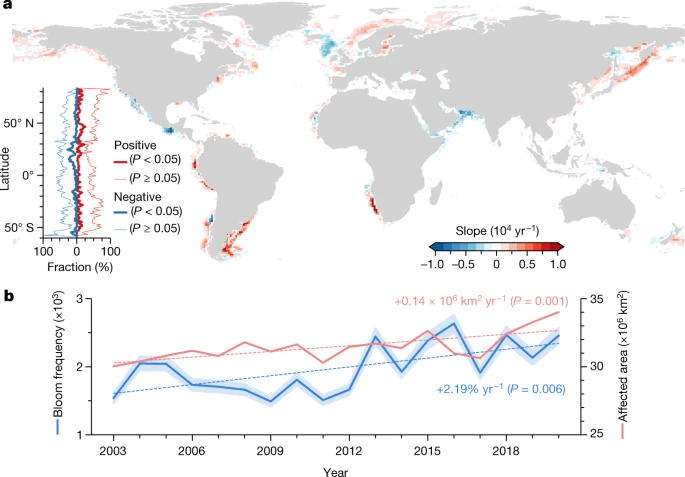These heat waves have led to toxic algae blooms that poison https://phys.org/news/2025-07-climate-major-algae-surge-canada.html
pecialized underwater hydrophones, meaning the aquatic version of microphones, to record and trace the sounds of marine life, allowing them to analyze the impact human activity is having on various species.
However, as detailed in a study published in the journal PLOS One, devastating heat waves have triggered worrying changes over the past decade, allowing toxic algae to bloom and undermine food sources for whales.
"It caused the most widespread poisoning of marine mammals ever documented," coauthor and Monterey Bay Aquarium Research Institute biological oceanographer John Ryan told NatGeo. "These were hard times for whales."
As a result, blue whale vocalizations dropped by almost 40 percent, according to the study, with populations of krill and anchovy collapsing.
"When you really break it down, it’s like trying to sing while you're starving," Ryan explained. "They were spending all their time just trying to find food."
Scientists are still racing to understand the causes of devastating marine heatwaves. An ominous pool of warm water in the ocean, nicknamed "The Blob" following its discovery in early 2013, confounded scientists.
https://www.yahoo.com/news/articles/scientists-alarmed-whales-suddenly-going-142738228.html
Climate change driving major algae surge in Canada's lakes, study finds
a dramatic uptick in lake algae production since the 1960s.
"Over the past 150 years, we've seen algae levels rise in most Canadian lakes, but in the 1960s, algae levels accelerated dramatically, increasing at a rate seven times faster than before," said Irene Gregory-Eaves, co-author and biology professor at McGill. "What was most surprising is that this happened even in remote lakes, far from any immediate sources of human pollution or development."
To identify the cause of these changes, the team combined the study of natural archives—lake sediment cores that date back to the 1800s—with machine learning techniques to detect long-term trends. They then compared those algae records with historical data on air temperature, solar radiation, and nearby human activity.
"Our research points clearly to climate change as the primary driver of the algae dynamics," said Dermot Antoniades, co-author and limnology professor at Université Laval. "As climates warm, lakes are getting warmer too, which create ideal conditions for algal growth.".............
local fixes alone, such as reducing fertilizer runoff, aren't enough anymore. Climate action is essential for protecting lakes in the long run," Ghanbari said.
Toxic algae blooms increasing in Arctic due to climate change, new study finds
The krill and copepods that ingest the toxins are then eaten by the bowhead whales, which are filter feeders.
Over the past century, sea surface temperatures in the region have been rising, causing the amount of sea ice to shrink significantly. The warmer waters combined with more open water is leading to the higher concentrations of at least two algal toxins: Alexandrium, which are dinoflagellates that produce saxitoxin -- a neurotoxin that can cause Paralytic Shellfish Poisoning; as well as domoic acid, which is produced by Pseudo-nitzschia, a needle-like group of single-celled algae, and causes amnesic shellfish poisoning, according to the study....
unclear how many whales in the Arctic have died as a result of harmful algae blooms, but walrus populations in the region, which feed on clams found at the bottom of the ocean, have been likely dying off as a result, Lefebvre said.
Lefebvre has been studying harmful algae blooms for her entire career and was involved in the first-ever study in 1998 that found domoic acid was impacting marine mammals in Central California.
Southern California is currently recovering from its worst harmful algal bloom event,............
New research finds that globally algal blooms became 13% larger and 60% more frequent in the last 20 years alone, expected to get more severe due to climate breakdown
https://www.reddit.com/r/science/comments/11g2cox/new_research_finds_that_globally_algal_blooms/
https://www.nature.com/articles/s41586-023-05760-y
However, proliferations of algae that cause harm (termed harmful algal blooms (HABs)) have become a major environmental problem worldwide5,6,7. For instance, the toxins produced by some algal species can accumulate in the food web, causing closures of fisheries as well as illness or mortality of marine species and humans8,9,10. In other cases, the decay of a dense algal bloom can deplete oxygen in bottom waters, forming anoxic ‘dead zones’ that can cause fish and invertebrate die-offs and ecosystem restructuring, with serious consequences for the well-being of coastal communities1,11. Unfortunately, algal bloom frequency and distribution are projected to increase with future climate change12,13, with some changes causing adverse effects on aquatic ecosystems, fisheries and coastal resources.


No comments:
Post a Comment